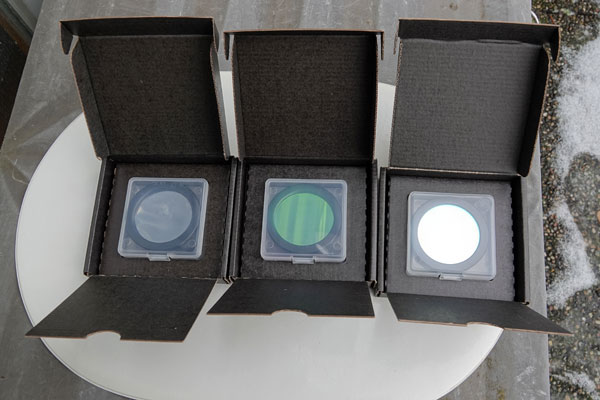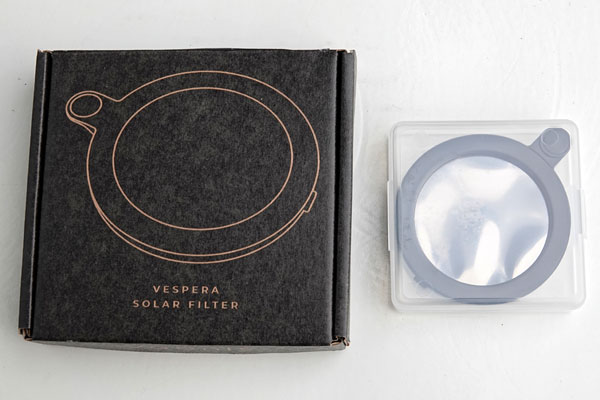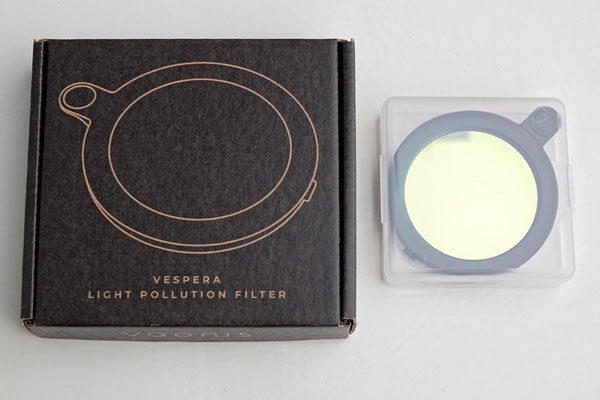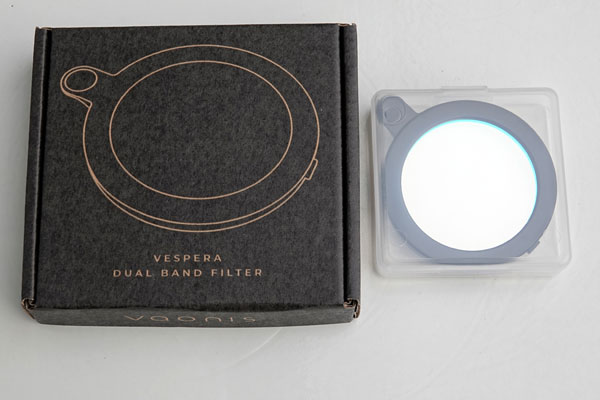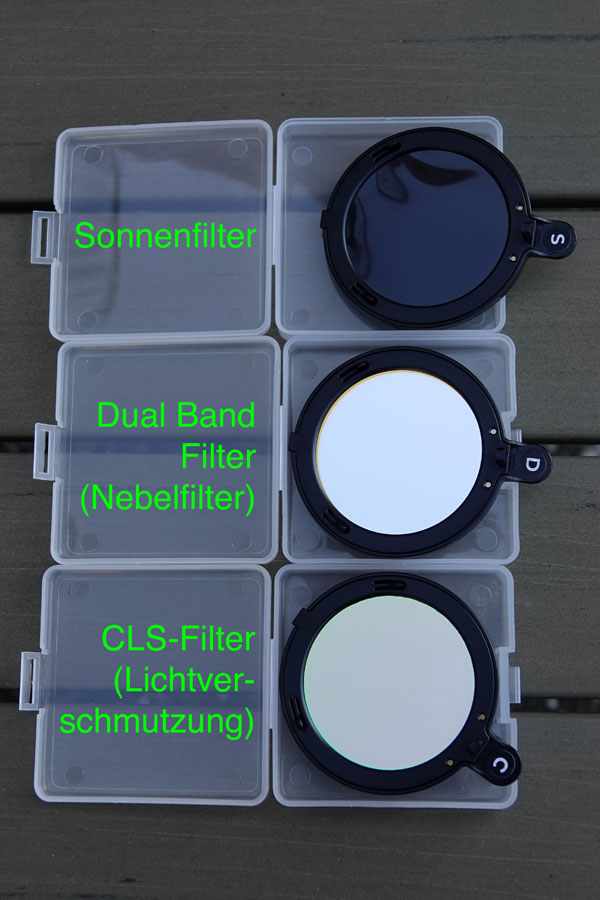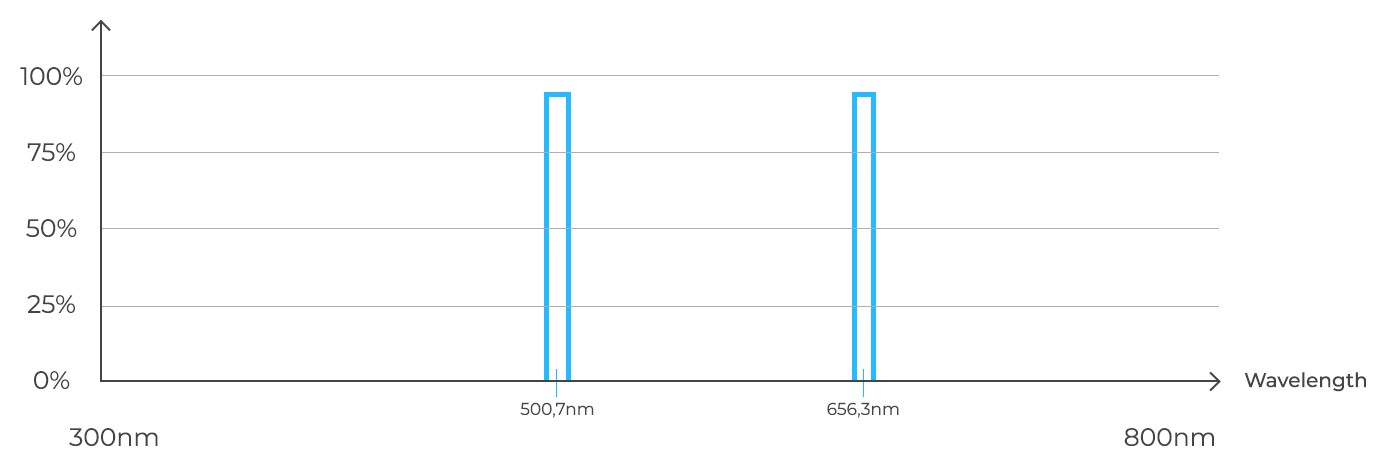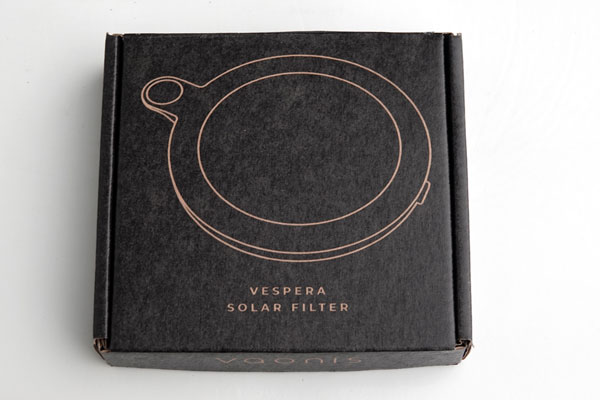Vaonis Vespera Pro - Observations with Filters
On this page, I collect information for the observation with filters with my Vaonis Vespera Pro.
See also pages:
Introduction
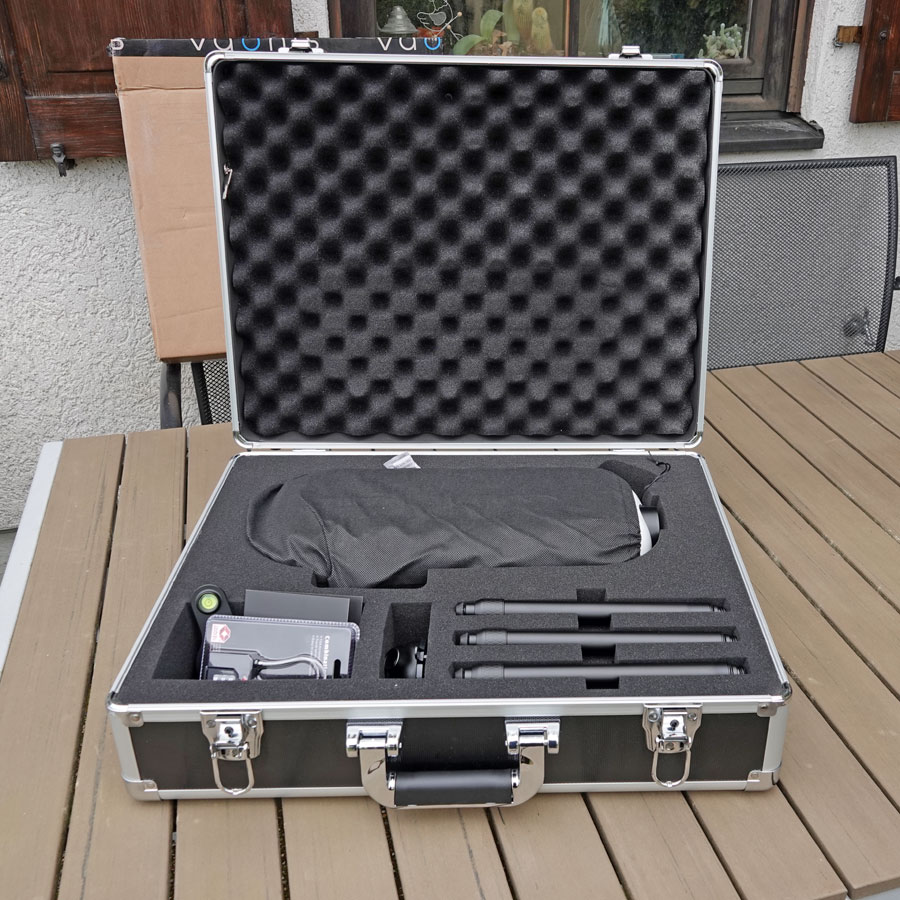 |
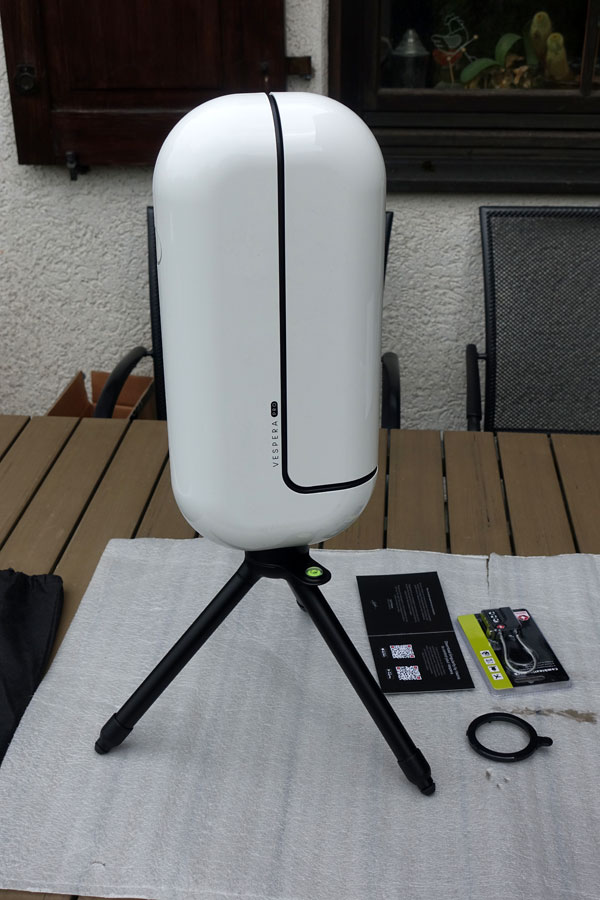 |
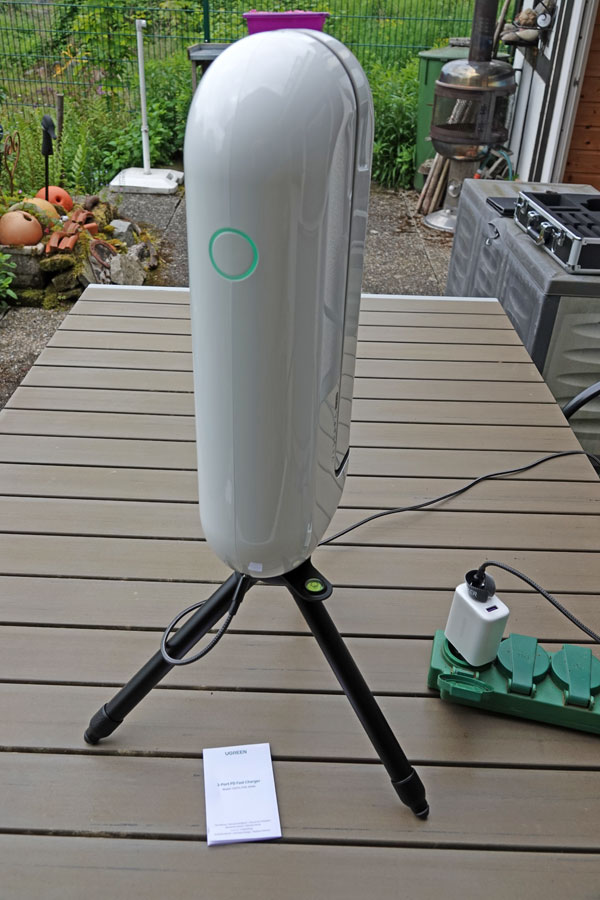 |
Photo: My Vaonis Vespera Pro (May 8, 2024)
For the various Vaonis Vespera telescopes, three filters are available:
- The Vespera Solar Filter,
- the Vespera Light Pollution Filter (CLS Filter),
- the Vespera Dual Band Filter
These filters are "full aperture" filters that are placed in front of the front lens; they are automatically recognized by the Vespera (and the software reacts accordingly to the filter used).
Note: The Singularity app shows whether a filter is used and if so, which one.
Photos
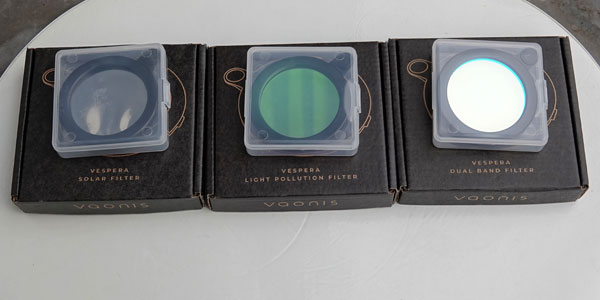 |
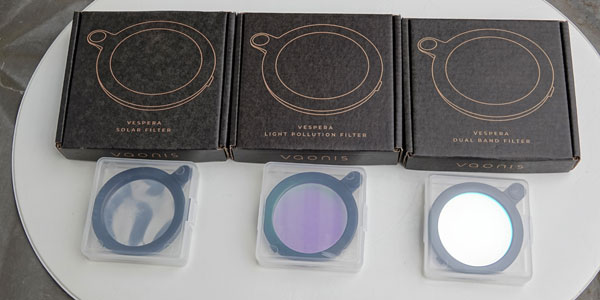 |
|||
The filters, outer boxes opened |
The filters... |
ditto... |
||
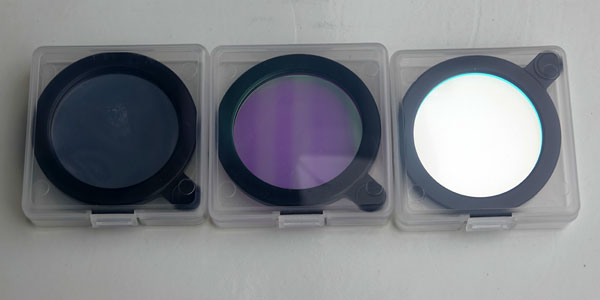 |
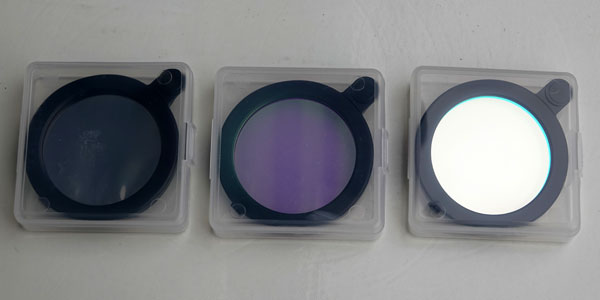 |
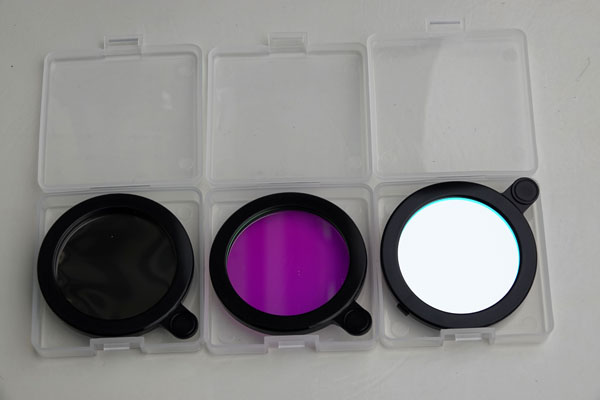 |
||
Ditto... |
Ditto... |
Ditto, boxes opened |
Photos: The filters (left: Solar Filter, center: Light Pollution Filter, right: Dual Band Filter
Solar Filter |
Light Pollution Filter |
Dual Band Filter |
||
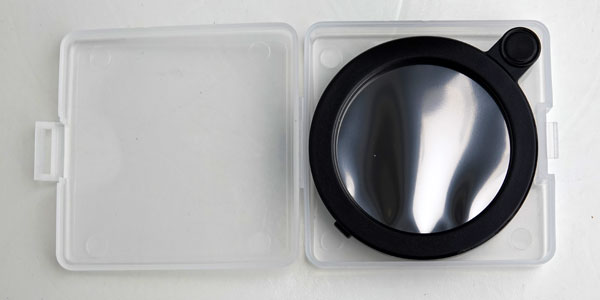 |
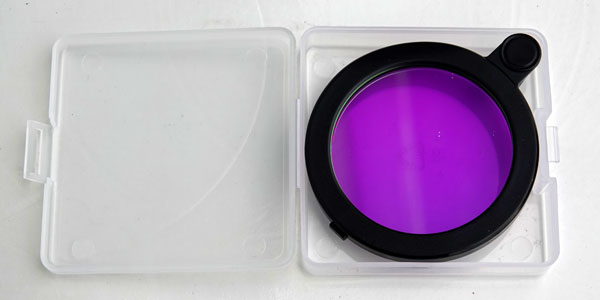 |
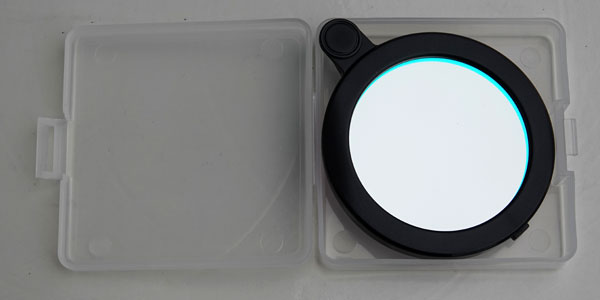 |
||
Solar Filter |
Light Pollution Filter |
Dual Band Filter |
Photos: The filters and their boxes
Photo: The backsides of the filters show the letters S, D, and C that help you distinguish between the filters
Note: The solar filter is covered on a separate page; it has a letter "S" on the "grip".
The Filters
Light Pollution Filter
 |
||
Light Pollution Filter |
Light Pollution Filter |
Description (from Vaonis):
The Vespera Light Pollution Filter or CLS (City Light Suppression) filter allows you to improve the quality of your photos when observing in the city or suburbs. It attenuates the effects of light pollution and thus increases the contrast between the celestial object being photographed and the background sky. It has a letter "C" at the "grip".
The broadband filter blocks wavelengths mainly emitted by urban night lighting or undesirable natural light, while allowing the main wavelengths from celestial objects.
- Essential for observing from an environment where light pollution is very present (urban and peri-urban environment, residential lighting, etc.)
- Improves the quality of nebula photography.
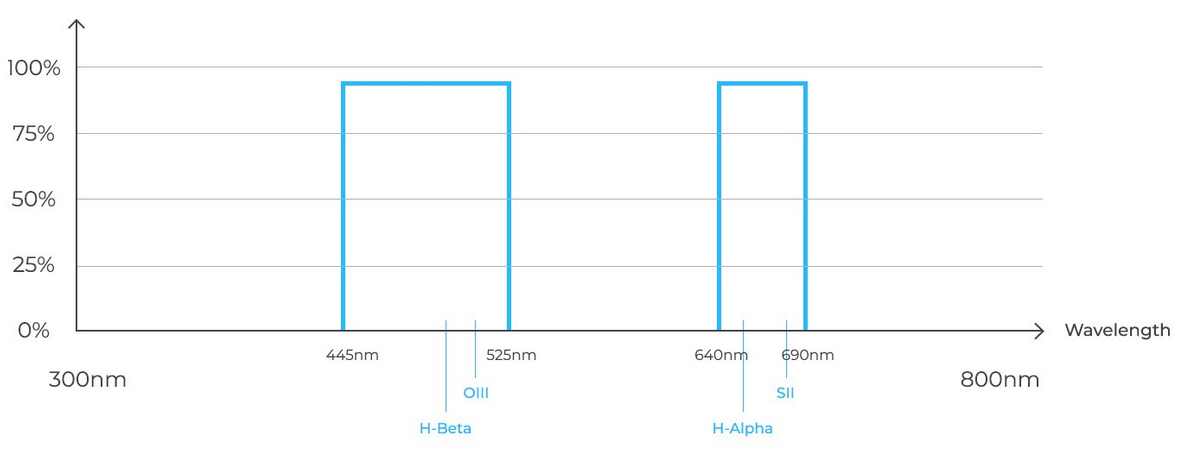
Diagram: Behavior of the Light Pollution Filter (from Vaonis Website, permission granted)
For more information see the respective page on the Vaonis Website.
Dual Band Filter
 |
||
Dual Band Filter |
Dual Band Filter |
Description (from Vaonis):
The Vespera Dual Band Filter is a dual narrowband interference filter that will significantly improve your photo quality whether you are viewing from an urban or natural environment. It has a letter "D" at the grip.
By selecting very precisely the wavelengths of Hydrogen Alpha (H-alpha) and Oxygen III (O-III) (bandwidth 12 nm), found mainly in nebulae, the filter will increase the contrast between the stellar object and the sky background. Thus, its use makes it possible to obtain a higher-quality image, with sharper stars and finer details.
The filter features 12 nm of bandwidth in each wavelength (O-III = 500.7 nm, H-alpha = 656.3 nm).
Diagramm: Behavior of the Dual Band Filter (from Vaonis Website, permission granted)
Vaonis recommends the filter as follows:
- Due to the filtered wavelengths, it is particularly effective for photographing nebulae in emission (e.g.: Orion nebula M42, Heart nebula IC 1805 …), dark nebulae endowed with hydrogen (e.g.: Horsehead or Elephant’s Trunk nebula…), planetary nebulae (e.g.: Owl nebula M97, Dumbbell nebula M27…), supernova remnants (e.g.: Veil nebula, Crab Nebula M1…).
- For globular clusters (e.g.: Hercules cluster M13, cluster M92…), the selectivity of the Dual Band filter will help you to obtain sharper stars.
For more information see the respective page on the Vaonis Website.
Solar Filter
 |
||
Solar Filter in its outer box... |
... and taken out of the boxes |
Since there is a solar filter for the Vespera available and the Singularity app was extended with a "solar mode" in time, you can also observe the sun in a simple way with the Vespera. In the article "Solar Mode with Vespera" of the Vaonis Knowledge Base (support.vaonis.com/portal/en/kb/articles/solar-mode-with-stellina) the procedure for observing the sun is described, so I do not want to repeat this here. In principle, sunspots are the easiest to photograph. Flares require post-processing of the photos, and further investigations make more work (see the article Observing the Sun with Vespera and Stellina). I myself have only observed sunspots so far.
For more information see the respective page on the Vaonis Website.
First Experiences with the Filters
My experiences with the three filters and my two Vespera telescopes are too extensive for reporting them on this page. I therefore report these on a series of pages to which I would like to refer to below.
Vaonis Vespera
- Vaonis Vespera - Observations with Filters (first experiences)
- Vaonis Vespera - Further Observations with the Dual Band Filter
- Vaonis Vespera - Dual Band Filter Photos and Topaz Denoise AI
- Vaonis Vespera - Further Observations with the CLS Filter
- Vaonis Vespera - Observations of the Sun
Vaonis Vespera Pro
- Vaonis Vespera Pro - Observations with the Dual Band Filter
- Vaonis Vespera Pro - Observations of the Sun
First Conclusions
Note: This conclusion is largely taken from the corresponding page for the original Vespera. There are no new points of view for the Vespera Pro.
Dual Band Filter
For all DSO, the Dual Band Filter shows a significant effect. While the effect is debatable for M 42/43 (more or less a change in color - and the loss of a dark nebula), the Dual Band Filter leads to significant quality improvenement for the other DSO. A welcome effect of the filter is also that stars are suppressed to a certain degree so that the objects in question better stand out. I find the price of 400 EUR for the Dual Band Filter high, but the improvement that I found seems to justify a purchase in my opinion. When you use the filter, you have the impression of owning a "much better" telescope...
A special effect was discovered by a star friend and also by me: photos with the Dual Band Filter can show clearly visible Walking Pattern Noise, while the respective photos without the filter do not. It turned out that this effect can only be observed with "normal" images, but not with mosaics. This is probably because mosaics use dithering (confirmed by Vaonis), which is considered the "tool of choice" for reducing or eliminating walking pattern noise. I will make appropriate comparison photos to investigate this in more detail.
Update: The Vespera Pro now also uses dithering in normal mode.
Light Pollution Filter (CLS Filter)
Stars are hardly or not at all affected by the CLS filter; nebulae, however, come out more clearly than without the filter. Whether the use of this filter is generally worthwhile when the sky is not disturbed by streetlights, I cannot yet judge. Nebulae are perhaps not only shown more vividly than without the filter, but possibly also in more natural colours than with the dual band filter. In any case, more photos taken with the CLS filter are necessary to be able to judge its impact.
Solar Filter
Observations of the sun are easily conducted with the Vaonis Vespera Pro and its solar filter. As with the original Vespera, however, I am somewhat disappointed of the low sharpness of the photos/sunspots.
Links
- Vaonis: vaonis.com/fr/ (FR), vaonis.com (EN)
- Vespera Light Pollution Filter: vaonis.com/product/vespera-light-pollution-filter (EN)
- Vespera Dual Band Filter: vaonis.com/product/vespera-dual-band-filter (EN)
- See also my page offering Astronomy Links.
| 17.04.2025 |
